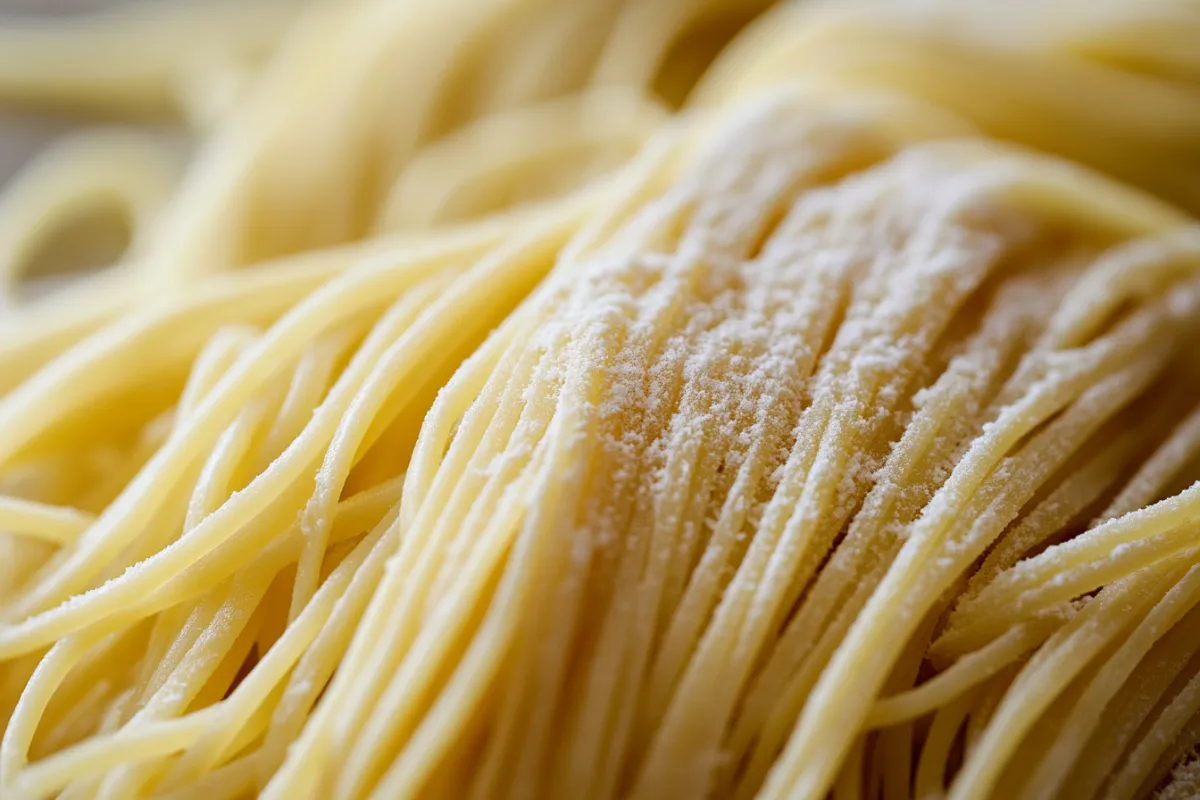Is Capellini the Same as Angel Hair? A Comprehensive Comparison
Capellini and angel hair pasta are two pasta varieties that are frequently confused due to their delicate and thin nature. However, although they look similar and are often used in the same types of dishes, they are not exactly the same. Understanding the differences between capellini and angel hair will help you make the right choice when it comes to preparing pasta dishes.
In this in-depth article, we’ll explore what sets capellini and angel hair apart, when to use each type of pasta, their respective origins, cooking methods, nutritional information, and how to pair them with various sauces and ingredients. By the end, you’ll be a pasta expert ready to choose the best thin pasta for your recipes.
For more inspiration on how to elevate your pasta dishes, don’t forget to check out our Ultimate Guide to Capellini Pasta, where we dive deep into recipe ideas, preparation tips, and more.
What is Capellini?
Capellini is a long, thin type of pasta that is slightly thicker than angel hair. The word capellini translates to “little hair” in Italian, which is a fitting description for this extremely fine pasta. With a diameter ranging between 0.85 mm and 0.92 mm, capellini is one of the thinnest types of pasta available, but it’s still just a bit heartier than angel hair.
History of Capellini
Like most pasta varieties, capellini has deep roots in Italian cuisine. It originated in Italy, where the abundance of wheat led to the development of various types of pasta. Capellini has traditionally been used in dishes that call for light ingredients, such as olive oil, tomatoes, and fresh herbs. Due to its fine texture, it’s often used in spring and summer recipes that feature seasonal produce.
If you are interested in learning more about traditional Italian dishes and their historical contexts, we recommend reading our article on The History Behind Chocolate, which provides fascinating insights into culinary traditions.
What is Angel Hair Pasta?
Angel hair pasta, also known as capelli d’angelo in Italian, is even finer than capellini. Its diameter typically falls between 0.78 mm and 0.88 mm, making it the thinnest pasta available. This delicate pasta is often used in dishes where the texture of the pasta is meant to be very light, such as in simple olive oil or butter-based sauces.
History of Angel Hair
Angel hair pasta has been around for centuries and was originally created in Italy as part of the pasta-making tradition in regions known for producing fine pasta shapes. Like capellini, it’s often served with fresh, light ingredients that do not overwhelm its delicate structure.
Angel hair is also a favorite for seafood-based dishes because it pairs well with the subtle flavors of ingredients such as shrimp, clams, and mussels.
The Key Differences Between Capellini and Angel Hair
While capellini and angel hair pasta are very similar, there are a few key differences that set them apart. These differences can influence which pasta you choose for your next meal, depending on the type of sauce and ingredients you’re using.
1. Thickness
- Capellini: Slightly thicker than angel hair, making it better suited for dishes with slightly heavier sauces, such as fresh tomato or light cream sauces.
- Angel Hair: Thinner than capellini, which means it cooks faster and works best with very light sauces such as olive oil, garlic, or butter.
2. Cooking Time
- Capellini: Requires 2-3 minutes of cooking time. This pasta’s slightly thicker texture means it can handle a bit more cooking time without becoming mushy.
- Angel Hair: Cooks in just 1-2 minutes. Due to its thinness, it is very easy to overcook angel hair, so careful attention is required when boiling.
3. Texture and Use in Recipes
- Capellini: Its slightly firmer texture makes it versatile enough to be used in dishes where heartier ingredients like meat or vegetables are present.
- Angel Hair: Best for delicate dishes that emphasize the pasta’s fine texture, such as those using seafood or simple, herb-based sauces.
4. Cooking Techniques
Both capellini and angel hair should be cooked in a large pot of salted water to avoid clumping. Since these pastas cook quickly, it’s important to drain them as soon as they reach the desired al dente texture.
For more detailed advice on perfecting the art of cooking pasta, check out our Ultimate Guide to Capellini.
Best Dishes and Recipes for Capellini and Angel Hair
Whether you’re using capellini or angel hair, these thin pasta varieties are best served with light, flavorful ingredients. Here are some of the best ways to prepare and enjoy both types of pasta.
Popular Capellini Recipes
- Capellini Pomodoro
- A classic Italian dish made with fresh tomatoes, garlic, olive oil, and basil.
- Best served with freshly grated parmesan cheese and a drizzle of olive oil.
- Capellini with Garlic and Olive Oil
- A simple, yet satisfying dish that highlights the flavors of fresh garlic and high-quality olive oil.
- Can be garnished with fresh parsley or crushed red pepper for extra flavor.
- Capellini with Seafood
- Works well with shrimp, clams, or mussels, and pairs beautifully with a white wine and garlic sauce.
Popular Angel Hair Recipes
- Angel Hair with Shrimp
- Light and delicate, this dish combines angel hair pasta with sautéed shrimp in a garlic-butter sauce.
- Angel Hair Primavera
- A vegetarian dish that features fresh vegetables like zucchini, cherry tomatoes, and bell peppers, tossed with angel hair in a light olive oil sauce.
- Angel Hair with Lemon and Basil
- A refreshing pasta dish made with lemon zest, basil, and a touch of parmesan. Perfect for summer meals.
How to Pair Capellini and Angel Hair with Sauces and Ingredients
Both capellini and angel hair are best paired with light sauces and ingredients that complement their delicate textures. Here are some pairing ideas for each pasta:
Best Sauces for Capellini:
- Light Tomato Sauce: Capellini Pomodoro is a classic dish that lets the thin strands of pasta absorb the fresh tomato sauce.
- Garlic and Oil: A simple garlic and olive oil sauce works wonders for capellini, especially when paired with fresh herbs.
- Seafood-Based Sauces: Capellini can handle light seafood sauces, making it an excellent base for dishes with shrimp or scallops.
Best Sauces for Angel Hair:
- Butter and Lemon: This combination works beautifully with the lightness of angel hair, creating a delicate yet flavorful dish.
- Olive Oil and Fresh Herbs: Simple sauces with olive oil, basil, and a hint of garlic highlight the pasta’s subtle flavor.
- White Wine Sauce: Perfect for seafood-based dishes, a light white wine sauce enhances the natural sweetness of shrimp, clams, or mussels.
Learn how to perfectly pair sauces with your pasta in our guide to the Ultimate Guide to Chocolate Bars, where we discuss the art of balancing flavors.
Nutritional Comparison: Capellini vs. Angel Hair
Though capellini and angel hair are very similar nutritionally, there are slight variations in terms of calorie content, fiber, and cooking methods that may make one a better choice depending on your dietary needs.
Standard Nutritional Information (per serving, approximately 100g):
- Capellini:
- Calories: 200
- Carbohydrates: 42g
- Protein: 7g
- Fiber: 2g
- Fat: 1g
- Angel Hair:
- Calories: 198
- Carbohydrates: 41g
- Protein: 6g
- Fiber: 2g
- Fat: 1g
Whole Wheat Options
Both capellini and angel hair are available in whole wheat versions, which provide more fiber and are a healthier option for those looking to increase their intake of whole grains.
Frequently Asked Questions (FAQs)
1. Is Capellini the Same as Angel Hair?
No, although they are very similar, capellini is slightly thicker than angel hair, which can affect the texture and cooking time. Capellini also holds up better to slightly heavier sauces, while angel hair is best for very light, delicate sauces.
2. Can I Substitute Capellini for Angel Hair?
Yes, you can generally substitute capellini for angel hair and vice versa in most recipes. However, be mindful of the cooking time, as angel hair cooks faster.
3. Which Pasta Cooks Faster, Capellini or Angel Hair?
Angel hair cooks faster due to its thinner diameter. It typically takes just 1-2 minutes to reach the desired texture, while capellini requires 2-3 minutes.
4. Is Angel Hair Healthier than Capellini?
Both pastas have similar nutritional profiles. The health benefits come more from what you serve with the pasta, such as vegetables or lean proteins, rather than the pasta itself.
5. Can I Use Capellini in Heavier Sauces?
While capellini is generally paired with lighter sauces, it can handle slightly more robust ingredients than angel hair. However, it’s best not to use either pasta in very heavy sauces like meat-based ragùs.
Conclusion: Which Pasta Should You Choose?
Choosing between capellini and angel hair ultimately depends on the type of dish you’re making. If you’re preparing a very light dish with olive oil or seafood, angel hair is likely the better option. On the other hand, if you’re working with slightly heartier ingredients, such as fresh tomatoes or light cream sauces, capellini may be more suitable.
Both types of pasta bring their own unique qualities to a dish, and with the right pairing of ingredients, you can create a meal that highlights their delicate textures.
Ready to cook? Check out more Italian cooking tips and pasta recipes in our Ultimate Guide to Capellini Pasta.


1 thought on “Is Capellini the Same as Angel Hair? Differences”